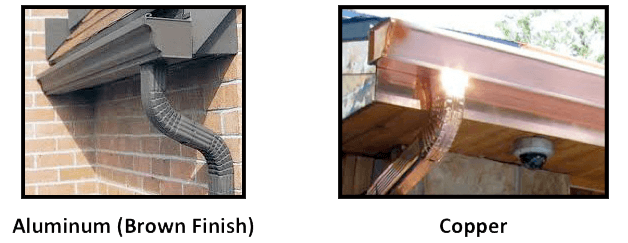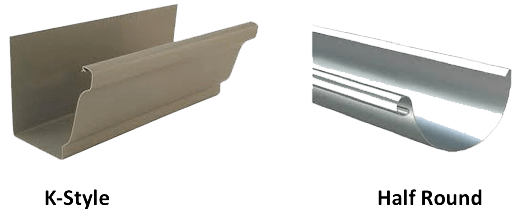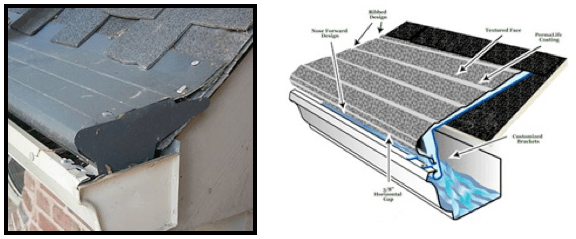

HIGHLY QUALIFIED INSTALLERS
We’re Here To Help With
If the hail was bad enough to damage your roof and/or siding then most likely your gutters will be damaged as well. There are also times, due to the design of the roof, that require replacing the gutters regardless of whether they were damaged by the storm or not. In either case your Tuttle Representative will examine your gutters along with the roof and the siding to fully assess any damage to your home.
And just like in the event there was siding damage; Tuttle Contracting will ensure everything that was damaged is included on one claim – meaning you only have the cost of one deductible. See our page on The Tuttle Method for more information on minimizing your out-of-pocket expense.
Gutter Damage
Typically, storm related damage to gutters is strictly cosmetic as most gutters today are aluminum, steel, or copper. In these cases there will be dents in the gutters, but they will still function as they originally did. But if you have PVC gutters, it is very likely the hail stones will have put holes through the gutters, looking similar to hail damaged vinyl siding.
In either event, damage is damage and is covered for replacement by your insurance policy. Since the gutters are likely still functioning properly and the damage may not be evident unless the sun catches it just right, this is often not acknowledged by the insurance adjuster without the presence of your Tuttle Representative. When held accountable, the insurance company knows they have to pay for the damage, but if they can minimize the claim they will attempt to do so. For more information on tactics used by the insurance companies see our page on Why Have an Inspection and Insurance Claim Aid/Tips.
Gutter Options
Unlike roofing or siding, guttering is limited on the options to choose from. There are only two viable options for material and two design styles; aluminum and copper, “K-style” and Half Round. Regardless of the design or material selected, professionally installed gutters should always be of a “seamless” design; meaning the only seams or joints are in the corners. This eliminates the old “leaky” gutters.
Today almost all gutters are made of aluminum, because they are economical, very functional, and come in a variety of powder-coated colors. Copper is very attractive and equally as functional but will be at least three times more expensive depending on the price of the raw copper material. If you have older gutters, it is possible they are made of steel or PVC. Steel is no longer used because of a short lifespan with the water rusting holes through the gutters. PVC is not considered an option among professionals as it breaks easily, isn’t seamless, and has a short lifespan; but it can still be purchased as home improvement warehouses.

K-style and Half Round refers to the shape of the gutter themselves. K-style is by far the most popular and most functional choice. Half Round gutters are better than nothing, but the only reason to choose them over K-style is for cosmetic reasons. You can see in the two pictures, the K-style gutter has an outer lip the curls in and acts as a stop if water is coming with such force it could spill over; Half Round gutters have no such design causing them to be less reliable.

The only other choice is guttering is the size, and there are only two sizes to choose from, 5 inch or 6 inch. Five inch gutters are the most common type of gutter for residential usage and more than adequate in most situations. Six inch gutters are usually only seen in commercial applications, but can be used on residential homes if an excessive amount of water is collecting in one area.
Ninety nine percent of customers will use aluminum 5” K-style gutters. Really the only choice is then deciding on a color. If you have special circumstances or need to redesign your guttering system, contact us to have a qualified Tuttle Representative meet with you at your home and assist in making the best selection for you.
Gutter Guards
One of the most common complaints about gutters is that they clog with leaves and debris and that they don’t work. If your home has trees close by, you really only have two options: clean the gutters regularly or install gutter guards. Most people don’t have the time or want to get up on the ladder a couple of times every year to clean out the gutters – gutter guards are your answer. But within gutter guards what design is recommended?
Let’s start by saying there is NO perfect gutter guard, each one will have strengths over another as well as weaknesses. Below is information on a number of options, but we have found simple is better. Tuttle Contracting recommends a simple aluminum mesh “cap” that attaches to the front edge of the gutter and extends under the first course of shingle. The mesh is wide enough to allow the water to flow though it without restriction, but it is small enough to keep out most any debris.

Below are some other gutter guard options:
Gutter helmets are a solid “lid” over the gutter and are designed on the principle the water will curl around the edge and drop into the gutter, similar to how a spilt glass of water runs down the cabinet and doesn’t just drip off the counter. The design is great for light rains, but we question the functionality on really heavy rains when the gutters are needed the most.

There are also gutter guards available that are a tighter mesh than the one we recommend. The objective of this type of guard is to virtually eliminate any debris from getting into the gutters. Good idea, but we believe there is a tradeoff of also blocking water flow and resulting in a pour-over gutter guard. Again, in the lighter rains it would work fine but the heavier rains with increased water flow would likely have complications.

Plastic gutter guards are also available and are usually less expensive, but this is definitely a case of you get what you pay for. These gutter guards don’t have the strength to hold up over time, they crack easily when new and get worse with exposure to sunlight, and many times create more problems than they solve by reducing the water flow and catching debris. Other types of gutter guards, such as foam have similar problems with trapping dirt and debris and eventually water doesn’t flow through them at all.

While guttering is much more simple than roofing or siding, it is just as important to your home. Too much water around the foundation of your home can cause oversaturation of the soil and heaving, creating foundation problems, windows & doors that don’t close properly, cracked flooring, leaking in basements, washout of flower beds and plants, and erosion of your landscaping. A properly designed guttering system can eliminate these problems without taking away from the cosmetic appeal of your home.
